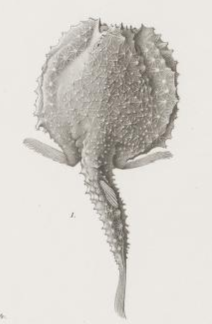
The pancake batfish, Atlantic pancake batfish, Louisiana pancake batfish or spiny batfish, is a species of marine ray-finned fish belonging to the family Ogcocephalidae, the deep sea batfishes or seabats. This species is found in the Western Atlantic Ocean.

Ogcocephalidae is a family of anglerfish specifically adapted for a benthic lifestyle of crawling about on the seafloor. Ogcocephalid anglerfish are sometimes referred to as batfishes, deep-sea batfishes, handfishes, and seabats. They are found in tropical and subtropical oceans worldwide. They are mostly found at depths between 200 and 3,000 m, but have been recorded as deep as 4,000 m (13,000 ft). A few species live in much shallower coastal waters and, exceptionally, may enter river estuaries.

The starry handfish, starry seabat or minipizza batfish, is species of marine ray-finned fish belonging to the family Ogcocephalidae, the deep-sea batfishes or seabats. This fish is found on the continental shelves of the Indo-Pacific oceans at depths of between 50 and 400 m. They are up to 30 cm long.

Halieutichthys is a genus of marine ray-finned fishes belonging to the family Ogcocephalidae, the deep-sea batfishes or sea bats. The fishes in this genus are found in the western Atlantic Ocean.

Halieutopsis is a genus of marine ray-finned fishes beloning to the family Ogcocephalidae, the deep sea batfishes. The species in this genus are found in the Indian and Pacific Oceans.

Malthopsis, the gnome batfishes or triangular batfishes, is a genus of marine ray-finned fishes belonging to the family Ogcocephalidae, the deep sea batfishes. The triangular batfishes are distributed throughout the warmer waters of the world, although they are absent from the Eastern Atlantic Ocean. The genus was originally proposed in 1891 by the British naturalist Alfred W. Alcock.

Coelophrys is a genus of marine ray-finned fishes belonging to the family Ogcocephalidae, the deep-sea batfishes or sea bats. The fishes in this genus are found in the western Pacific Ocean and the Indian Ocean.

Dibranchus is a genus of marine ray-finned fishes belonging to the family Ogcocephalidae, the deep sea batfishes. The fishes in this genus are widely distributed in the Atlantic, Indian and Pacific Oceans.

Halicmetus is a genus of marine ray-finned fishes belonging to the family Ogcocephalidae, the deep sea batfishes. The fishes in this genus are widely distributed in the Indian and Western Pacific Oceans.
Solocisquama is a genus of marine ray-finned fishes belonging to the family Ogcocephalidae, the deep sea batfishes. The species in this genus are benthic fishes found in deep waters in the Indian and Pacific Oceans.
Halieutichthys bispinosus, the two-spine batfish or spiny batfish, is a species of marine ray-finned fish belonging to the family Ogcocephalidae, the deep sea batfishes or seabats. This species is found in the Western Atlantic Ocean.

Malthopsis gnoma, the Atlantic triangular batfish, gnome seabat or grotesque seabat, is a species of marine ray-finned fish belonging to the family Ogcocephalidae, the deep-sea batfishes. The grotesque seabat is found in the Western Atlantic Ocean, in the Gulf of Mexico and Caribbean.
Halieutopsis taiwanea, the Taiwan deepsea batfish, is a species of marine ray-finned fish belonging to the family Ogcocephalidae, the deep sea batfishes. This species is found in the northwestern Pacific Ocean off Taiwan.

Halieutopsis stellifera, the starry deepsea batfish, is a species of marine ray-finned fish belonging to the family Ogcocephalidae, the deep sea batfishes. This species is found in the Indo-West Pacific region.

Halieutopsis simula, the fluffy-esca deepsea batfish, is a species of marine ray-finned fish belonging to the family Ogcocephalidae, the deep sea batfishes. This species is found in the Indo-West Pacific region.

Halieutopsis tumifrons,the truncate-snout deepsea batfish, is a species of marine ray-finned fish belonging to the family Ogcocephalidae, the deep-sea batfishes. This species is the type species of the genus Halieutopsis. It is a little known species only known from the two type specimens collected off the Galápagos Islands in 1890.

Halieutopsis nasuta, the big-nosed deepsea batfish, is a species of ray-finned fish belonging to the family Ogcocephalidae, the deep sea batfishes. This fish is found in the Indian and Pacific Oceans. H. nasuta is classified within the genus Dibranchus by some authorities, but is generally considered to belong in the genus Halieutopsis.

Halieutaea indica, the Indian batfish, Indian handfish or Indian seabat, is a species of marine ray-finned fish belonging to the family Ogcocephalidae, the deep sea batfishes. The Indian batfish has a wide Indo-West Pacific distribution.

The Caribbean batfish, also known as the two-spine batfish, is a species of marine ray-finned fish belonging to the family Ogcocephalidae, the deep sea batfishes or seabats. This species is found in the Western Atlantic Ocean.
Malthopsis bradburyae, Bradbury's triangular batfish, is a species of marine ray-finned fish belonging to the family Ogcocephalidae, the deep-sea batfishes. This little known species is found in the western Indian Ocean off Tanzania and is named in honour of the American ichthyologist Margaret G. Bradbury.
















